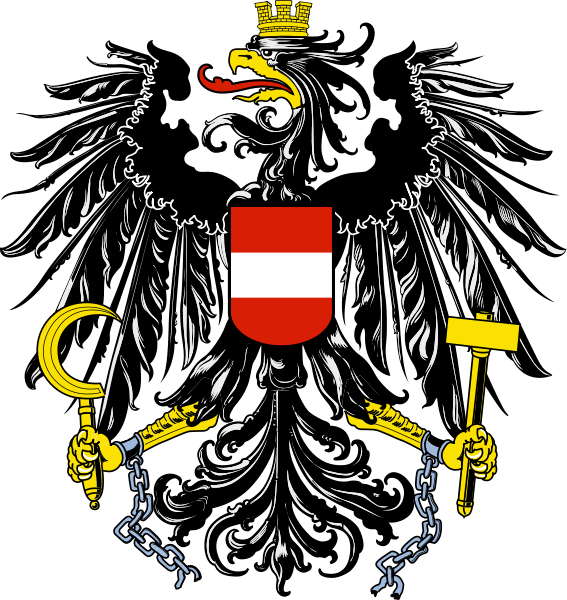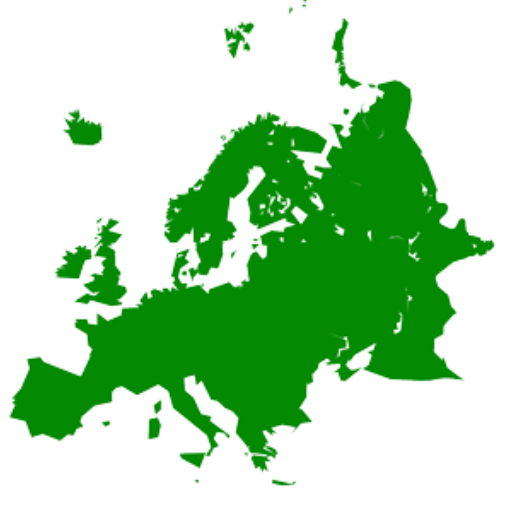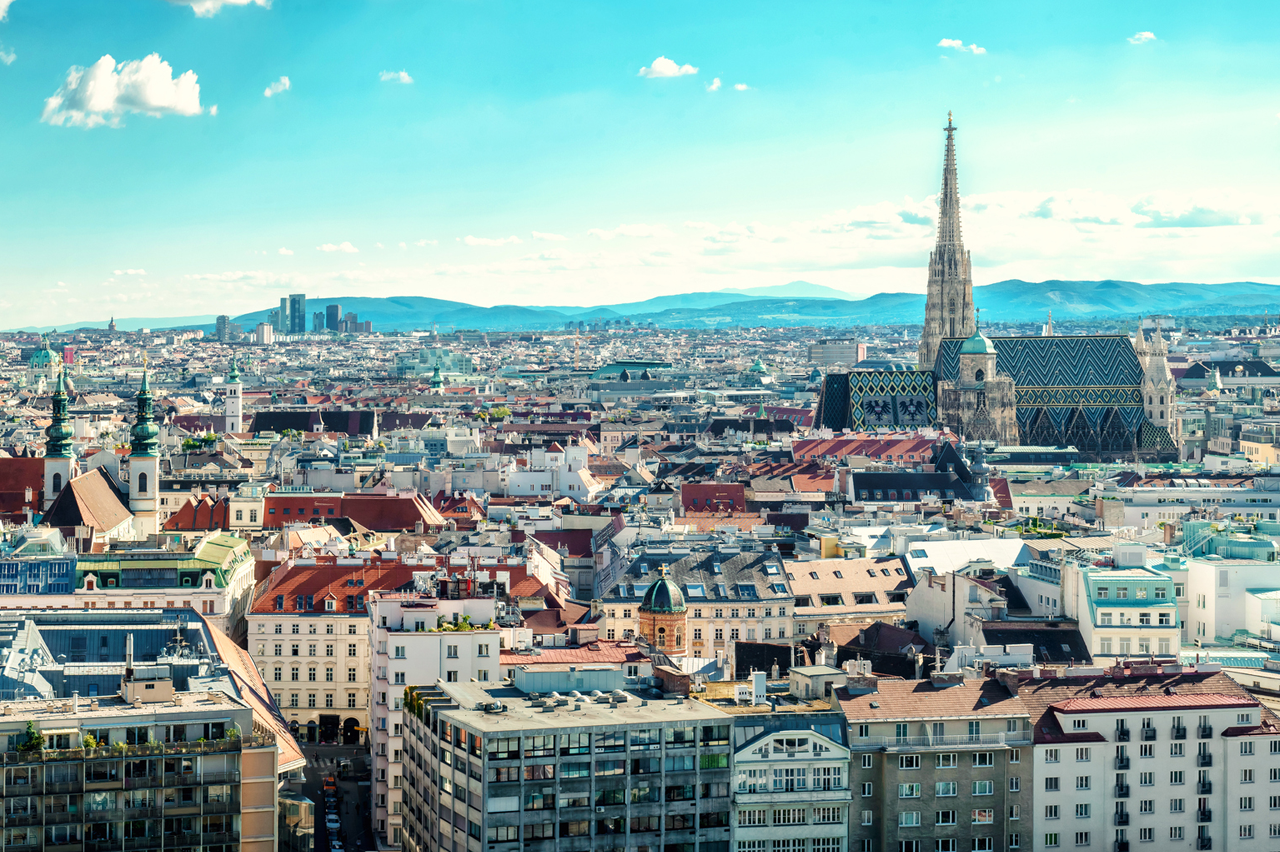
German — Chinese


 Geography
Geography

 Geography
***IMF Developed countries
Geography
***IMF Developed countries
 IMF Developed countries
IMF Developed countries
 IMF Developed countries
TOP5
IMF Developed countries
TOP5
 Austria
Austria

 States of Europe
States of Europe

奥地利共和国(![]() Republik Österreich 帮助·信息),通称奥地利(德语:Österreich [ˈøːstɐˌʁaɪç]
Republik Österreich 帮助·信息),通称奥地利(德语:Österreich [ˈøːstɐˌʁaɪç] ![]() 聆听),是一个位于中欧的内陆国家,但在历史上也被分类成西欧或者东欧的主权国家。[注 1]奥地利与多国接壤,东面是匈牙利和斯洛伐克,南面是意大利和斯洛文尼亚,西面是列支敦士登和瑞士,北面是德国和捷克。首都兼最大城市是维也纳,人口超过170万。[7][8]国土面积83,855平方千米(32,377平方英里),同时由于阿尔卑斯山的存在,奥地利成为了一个山地国,只有32%的国土海拔低于500米(1,600英尺),最高点海拔3,798米(12,461英尺)。[7]
聆听),是一个位于中欧的内陆国家,但在历史上也被分类成西欧或者东欧的主权国家。[注 1]奥地利与多国接壤,东面是匈牙利和斯洛伐克,南面是意大利和斯洛文尼亚,西面是列支敦士登和瑞士,北面是德国和捷克。首都兼最大城市是维也纳,人口超过170万。[7][8]国土面积83,855平方千米(32,377平方英里),同时由于阿尔卑斯山的存在,奥地利成为了一个山地国,只有32%的国土海拔低于500米(1,600英尺),最高点海拔3,798米(12,461英尺)。[7]
如今的奥地利是一个半总统制的代议民主国家,下含九个联邦州。[7][9]奥地利是当今世界最富裕的国家之一,2012年的人均国民生产总值达到46,330美元。其人类发展指数在2014年排世界第21位。同时自1995年以来就是欧盟成员,[7][10]是OECD的创始国之一。[11]1995年签订申根公约,[12]1999年接受并于2002年起使用欧元。奥地利曾是统治中欧650年到1918年哈布斯堡王朝的核心部分,维也纳是神圣罗马帝国和奥匈帝国的首都,并且奥地利在民族上属于日耳曼民族的居住地,和德国、瑞士、卢森堡同为德语区,在历史上和中欧及东欧的的匈牙利、捷克、波兰都有紧密的关联。
Österreich (amtlich Republik Österreich) ist ein mitteleuropäischer Binnenstaat mit rund 8,9 Millionen Einwohnern. Die angrenzenden Staaten sind Deutschland und Tschechien im Norden, Slowenien und Italien im Süden, die Slowakei und Ungarn im Osten sowie die Schweiz und Liechtenstein im Westen.
Österreich ist ein demokratischer und föderaler Bundesstaat, im Besonderen eine semipräsidentielle Republik. Seine großteils aus den historischen Kronländern hervorgegangenen neun Bundesländer sind das Burgenland, Kärnten, Niederösterreich, Oberösterreich, Salzburg, die Steiermark, Tirol, Vorarlberg und Wien. Das Bundesland Wien ist zugleich Bundeshauptstadt und einwohnerstärkste Stadt des Landes. Weitere Bevölkerungszentren sind Graz, Linz, Salzburg und Innsbruck.
Das Land wird von der Böhmischen Masse und der Thaya im Norden, den Karawanken und dem Steirischen Hügelland im Süden, der Pannonischen Tiefebene im Osten und dem Rhein und dem Bodensee im Westen begrenzt. Mehr als 62 Prozent seiner Staatsfläche werden von alpinem Hochgebirge gebildet.
Die Bezeichnung Österreich ist in ihrer althochdeutschen Form Ostarrichi erstmals aus dem Jahr 996 überliefert. Zudem war die lateinische Form Austria in Verwendung. Ursprünglich eine Grenzmark des Stammesherzogtums Baiern, wurde Österreich 1156 ein im Heiligen Römischen Reich eigenständiges Herzogtum. Nach dem Aussterben des Geschlechts der Babenberger 1246 setzte sich das Haus Habsburg im Kampf um die Herrschaft in Österreich durch. Das als Österreich bezeichnete Gebiet umfasste später die gesamte Habsburgermonarchie sowie später das 1804 konstituierte Kaisertum Österreich und die österreichische Reichshälfte der 1867 errichteten Doppelmonarchie Österreich-Ungarn.
Die heutige Republik entstand ab 1918, nach dem für Österreich-Ungarn verlorenen Ersten Weltkrieg, aus den zunächst Deutschösterreich genannten deutschsprachigen Teilen der früheren Monarchie. Mit dem Vertrag von Saint-Germain wurden die Staatsgrenze und der Name Republik Österreich festgelegt. Damit einher ging der Verlust Südtirols. Die Erste Republik war von innenpolitischen Spannungen geprägt, die in einen Bürgerkrieg und die Ständestaatsdiktatur mündeten. Durch den sogenannten „Anschluss“ stand das Land ab 1938 unter nationalsozialistischer Herrschaft. Nach der Niederlage des Deutschen Reiches im Zweiten Weltkrieg wieder ein eigenständiger Staat, erklärte Österreich am Ende der alliierten Besatzung 1955 seine immerwährende Neutralität und trat den Vereinten Nationen bei. Österreich ist seit 1956 Mitglied im Europarat, Gründungsmitglied der 1961 errichteten Organisation für wirtschaftliche Zusammenarbeit und Entwicklung (OECD) und seit 1995 ein Mitgliedsstaat der Europäischen Union.
オーストリア共和国(オーストリアきょうわこく、ドイツ語: Republik Österreich、バイエルン語: Republik Östareich)、通称オーストリアは、ヨーロッパに位置する連邦共和制国家。首都はウィーン。
ドイツの南方、中部ヨーロッパの内陸に位置し、西側はリヒテンシュタイン、スイスと、南はイタリアとスロベニア、東はハンガリーとスロバキア、北はドイツとチェコと隣接する。基本的には中欧とされるが、歴史的には西欧や東欧に分類されたこともある。
中欧に650年間ハプスブルク家の帝国として君臨し、第一次世界大戦まではイギリス、ドイツ、フランス、ロシアと並ぶ欧州五大国(列強)の一角を占めていた。1918年、第一次世界大戦の敗戦と革命により1867年より続いたオーストリア=ハンガリー帝国が解体し、共和制(第一共和国)となった。この時点で多民族国家だった旧帝国のうち、かつての支配民族のドイツ人が多数を占める地域におおむね版図が絞られた。1938年には同じ民族の国家であるナチス・ドイツに併合されたが、ドイツ敗戦後の1945年から1955年には連合国軍による分割占領の時代を経て、1955年の独立回復と永世中立国化により現在に続く体制となった。
音楽を中心に文化大国としての歴史も有する。EU加盟以降は、同言語・同民族の国家同士でありながら複雑な国際関係が続いてきたドイツとの距離が再び縮まりつつあり、国内でも右派政党の伸張などドイツ民族主義の位置づけが問われている。
本項ではおもに1955年以降のオーストリア共和国に関して記述する。それ以前についてはオーストリアの歴史、ハプスブルク君主国、オーストリア公国、オーストリア大公国、オーストリア帝国、オーストリア=ハンガリー帝国、第一共和国 (オーストリア)、アンシュルス、連合軍軍政期 (オーストリア) を参照。
Austria (/ˈɒstriə/ (![]() listen), /ˈɔːs-/;[9] German: Österreich [ˈøːstɐʁaɪ̯ç] (
listen), /ˈɔːs-/;[9] German: Österreich [ˈøːstɐʁaɪ̯ç] (![]() listen)), officially the Republic of Austria (German: Republik Österreich,
listen)), officially the Republic of Austria (German: Republik Österreich, ![]() listen (help·info)), is a landlocked East Alpine country in the southern part of Central Europe. It is composed of nine federated states (Bundesländer), one of which is Vienna, Austria's capital and its largest city. It is bordered by Germany to the northwest, Czech Republic to the north, Slovakia to the northeast, Hungary to the east, Slovenia and Italy to the south, and Switzerland and Liechtenstein to the west. Austria occupies an area of 83,879 km2 (32,386 sq mi) and has a population of nearly 9 million people. While German is the country's official language,[10] many Austrians communicate informally in a variety of Bavarian dialects.[11]
listen (help·info)), is a landlocked East Alpine country in the southern part of Central Europe. It is composed of nine federated states (Bundesländer), one of which is Vienna, Austria's capital and its largest city. It is bordered by Germany to the northwest, Czech Republic to the north, Slovakia to the northeast, Hungary to the east, Slovenia and Italy to the south, and Switzerland and Liechtenstein to the west. Austria occupies an area of 83,879 km2 (32,386 sq mi) and has a population of nearly 9 million people. While German is the country's official language,[10] many Austrians communicate informally in a variety of Bavarian dialects.[11]
Austria initially emerged as a margraviate around 976 and developed into a duchy and archduchy. In the 16th century, Austria started serving as the heart of the Habsburg Monarchy and the junior branch of the House of Habsburg – one of the most influential royal dynasties in history. As an archduchy, it was a major component and administrative centre of the Holy Roman Empire. Early in the 19th century, Austria established its own empire, which became a great power and the leading force of the German Confederation but pursued its own course independently of the other German states. Following the Austro-Prussian War and the compromise with Hungary, the Dual Monarchy was established.
Austria was involved in World War I under Emperor Franz Joseph following the assassination of Archduke Ferdinand, the presumptive successor to the Austro-Hungarian throne. After the defeat and the dissolution of the Monarchy, the Republic of German-Austria was proclaimed with the intent of the union with Germany, which eventually failed because of the Allied Powers and the state remained unrecognized. In 1919 the First Austrian Republic became the legal successor of Austria. In 1938, the Austrian-born Adolf Hitler, who became the Chancellor of the German Reich, achieved the annexation of Austria by the Anschluss. Following the defeat of Nazi Germany in 1945 and an extended period of Allied occupation, Austria was re-established as a sovereign and self-governing democratic nation known as the Second Republic.
Austria is a parliamentary representative democracy with a directly elected Federal President as head of state and a Chancellor as head of the federal government. Major urban areas of Austria include Graz, Linz, Salzburg and Innsbruck. Austria is consistently ranked in the top 20 richest countries in the world by GDP per capita terms. The country has achieved a high standard of living and in 2018 was ranked 20th in the world for its Human Development Index. Vienna consistently ranks in the top internationally on quality-of-life indicators.[12]
The Second Republic declared its perpetual neutrality in foreign political affairs in 1955. Austria has been a member of the United Nations since 1955 and[13] joined the European Union in 1995.[14] It plays host to the OSCE and OPEC and is a founding member of the OECD and Interpol.[15] Austria also signed the Schengen Agreement in 1995,[16] and adopted the euro currency in 1999.[17]
L'Autriche (en allemand : Österreich Écouter), en forme longue la république d'Autriche (en allemand : Republik Österreich), est un État fédéral d'Europe centrale sans accès à la mer. Pays montagneux, il est entouré, dans le sens des aiguilles d'une montre, par l'Allemagne et la République tchèque au nord, la Slovaquie et la Hongrie à l'est, la Slovénie et l'Italie au sud, et par la Suisse et le Liechtenstein à l'ouest. L'Autriche est membre de l'Union européenne et de la zone euro respectivement depuis 1995 et 1999. Sa langue officielle est l'allemand, mais depuis la ratification de la Charte européenne des langues régionales ou minoritaires, six autres langues (hongrois, slovène, croate du Burgenland, tchèque, slovaque et romani) sont reconnues4. Sa capitale et plus grande ville est Vienne.
L'Autriche est l'un des États issus de la dislocation en 1918 de l'Autriche-Hongrie. Par le passé, elle a été un acteur majeur de l'histoire de l'Europe, au cœur de grandes entités politiques telles que le Saint-Empire romain germanique, la monarchie de Habsbourg, l'empire d'Autriche et la Confédération germanique. Les nombreuses épreuves temporelles qu'elle a vécu a fait de ce pays une grande puissance mondiale. Mais, depuis la fin de la Seconde Guerre mondiale, l'Autriche a adopté une politique de neutralité dans les relations internationales5.
L'Austria (in tedesco: Österreich, /ˈʔœstɐˌʀaɪ̯ç/; in austro-bavarese: Ésterreich), ufficialmente Repubblica d'Austria (in tedesco: Republik Österreich; /ʀepu'bli:k ˈʔœstɐˌʀaɪ̯ç/), è una repubblica federale composta da nove Länder[5], membro dell'Unione europea, situato nell'Europa centrale. Confina con Svizzera (Cantone dei Grigioni, Canton San Gallo) e Liechtenstein ad ovest, Slovenia a sud-est, Italia (Friuli-Venezia Giulia, Trentino-Alto Adige, Veneto) a sud, Ungheria a est, Slovacchia a nord-est, Germania (Baviera) e Repubblica Ceca a nord.
Stato senza sbocco sul mare, con capitale la città di Vienna posta sulle rive del fiume Danubio, le sue origini moderne risalgono al IX secolo, quando il territorio dell'Alta e della Bassa Austria divenne sempre più popolato. Il nome Ostarrichi è attestato per la prima volta in un documento ufficiale dal 996 di Ottone I. Da allora questa parola si evolse in Österreich.[6]
È una democrazia rappresentativa parlamentare (sebbene il presidente sia eletto direttamente dai cittadini) ed è uno dei sei paesi europei che hanno dichiarato la neutralità permanente[7], nonché tra i pochi paesi al mondo che include il concetto di neutralità eterna nella sua costituzione. È membro delle Nazioni Unite dal 1955[8] mentre l'ingresso nell'Unione europea è avvenuto il 1º gennaio 1995.
La denominación oficial de República de Austria (en alemán, Republik Österreich), refiere a un Estado centroeuropeo, miembro de la Unión Europea, con capital en Viena, con una población de 8,9 millones de habitantes.4
Limita con la República Checa y Alemania al norte, Eslovaquia y Hungría al este, Eslovenia e Italia al sur, y Suiza y Liechtenstein al oeste. No tiene salida al mar, aunque está atravesada en una parte significativa por el río Danubio, navegable en gran parte de su recorrido. El territorio abarca 83 871 km² de superficie1 y el clima predominante es el alpino. Solo el 32% del país está por debajo de los 500 metros de altitud, y el punto más alto es el pico Grossglockner con 3798 m.s.n.m.5 La mayoría habla alemán,6 idioma oficial, aunque se hablan otros idiomas oficiales en zonas concretas como el croata, el esloveno y el húngaro.
Sus orígenes se remontan a la dinastía de los Habsburgo que convirtió al país en una parte fundamental del Sacro Imperio Romano Germánico. En 1867, el Imperio austríaco se convirtió en el Imperio austro-húngaro. El Imperio de los Habsburgo terminó en 1918 al finalizar la Primera Guerra Mundial.
La Primera República de Austria se estableció en 1919. En 1938, mediante el proceso conocido como el Anschluss, el país fue ocupado por la Alemania Nazi, hasta el final de la Segunda Guerra Mundial, cuando Austria volvería a recuperar su independencia. En 1955, se creó la Segunda República de Austria.
Austria tiene un gobierno parlamentario con una democracia representativa compuesta por nueve estados.57 La mayor ciudad es su capital, Viena, con 1,79 millones de habitantes. Es uno de los países más ricos del mundo, con una renta per cápita, para 2014, de €38.500.8 El país tiene una de las tasas más altas de Índice de Desarrollo Humano y un desempleo del 9,1 en 2015. Ha sido miembro de las Naciones Unidas desde 1955 y de la Unión Europea desde 1995. Es miembro fundador de la OCDE. Su moneda es el euro, adoptado en 1999.
А́встрия (нем. Österreich, МФА (нем.): [ˈøːstɐˌʁaɪç] ![]() слушать), официальное название — Австри́йская Респу́блика (Republik Österreich) — государство в Центральной Европе. Население составляет 8,46 млн человек, территория — 83 879 км². Занимает 94-е место в мире по численности населения и 112-е по территории.
слушать), официальное название — Австри́йская Респу́блика (Republik Österreich) — государство в Центральной Европе. Население составляет 8,46 млн человек, территория — 83 879 км². Занимает 94-е место в мире по численности населения и 112-е по территории.
Столица — Вена. Государственный язык — немецкий.
Федеративное государство, парламентская республика. С 7 января 2020 года федеральным канцлером является Себастьян Курц.
Подразделяется на 9 федеральных земель: Бургенланд, Каринтия, Нижняя Австрия, Верхняя Австрия, Зальцбург, Тироль, Штирия, Форарльберг, Вена.
На севере граничит с Чехией (362 км), на северо-востоке — со Словакией (91 км), на востоке — с Венгрией (366 км), на юге — со Словенией (330 км) и Италией (430 км), на западе — с Лихтенштейном (35 км) и Швейцарией (164 км), на северо-западе — с Германией (784 км).
Около 74 % населения католики.
Индустриальная страна с динамично развивающейся экономикой. Объём ВВП по паритету покупательной способности за 2017 год составил 441 млрд долларов США (около 50 000 долларов на душу населения). Денежная единица — евро.
Член Организации Объединённых Наций, Европейского союза. В 1955 году провозгласила постоянный нейтралитет и неприсоединение к каким-либо военным блокам.







